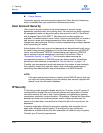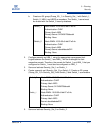
3 – Planning
Internet Protocol Support
59265-02 A 3-15
A
Network Time Protocol (NTP): Provides for the synchronizing of switch
and workstation dates and times with an NTP server. This helps to prevent
invalid SSL certificates and timestamp confusion in the event log. The
default is disabled.
Common Information Model (CIM): Provides for the management of the
switch through third-party applications that use the Storage Management
Initiative–Specification (SMI-S). The default is enabled.
File Transfer Protocol (FTP): Provides for transferring files rapidly between
the workstation and the switch using FTP. The default is enabled.
Management Server (MS): Enables or disables the management of the
switch through third-party applications that use GS-3 Management Server.
The default is disabled.
Call Home: Provides for automated e-mail notification of switch status and
operating conditions based on specified event severity levels. The Call
Home service is enabled by default. The Call Home service requires an
Ethernet connection to at least one Simple Mail Transfer Protocol (SMTP)
server. You must configure the Call Home service to do the following:
Enable primary and secondary SMTP servers and specify their IP
addresses
Specify contact information
Configure one or more Call Home profiles to specify mail recipients,
message format, and the event severity level that will initiate a
message.
Furthermore, you can configure periodic event data collection and processing
through the Tech_Support_Center profile for automated status and trend analysis.
Internet Protocol Support
The switch supports IP version 4, IP version 6, and Domain Name System (DNS)
host names. IP versions 4 and 6 are enabled by default. Consider your IP version
requirements and the availability of a DNS server.
Security
Security is available at the following levels:
User Account Security
IP Security
Port Binding
Connection Security


















